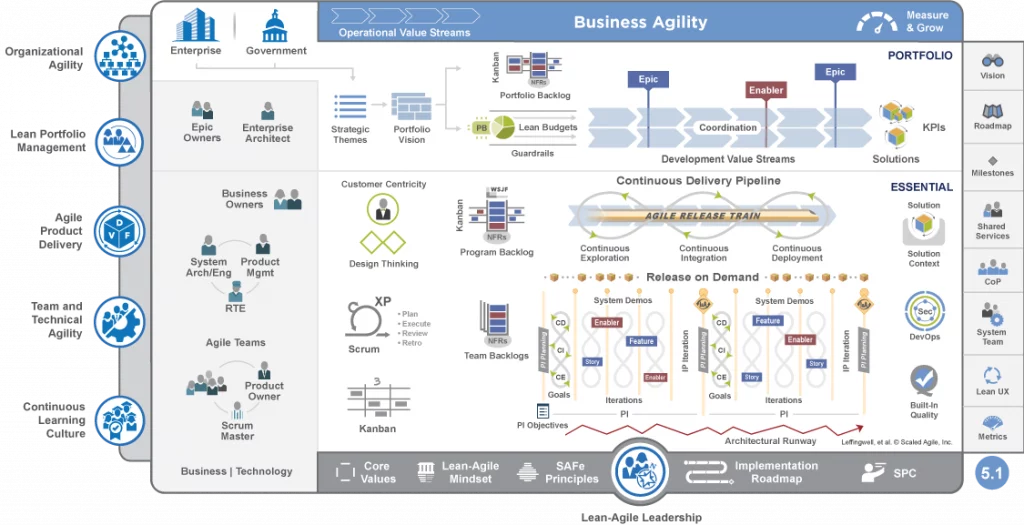
Recently I’ve transitioned from working as a Release Train Engineer (RTE) to an Enterprise Agile Coach. While the RTE career path isn’t always well defined, this has been a rewarding journey personally for my professional development and collectively for growing our organizational capabilities.
In this blog post, I discuss:
- Enterprise Agile Coach as a potential development path for RTEs
- My personal experience nine months into the role and what an Enterprise Agile Coach does in a SAFe® context
- Learning paths for RTEs and several key insights
Pointing the Release Train Engineer Career Path toward Enterprise Agile Coach
If you look at the SAFe Big Picture (in any configuration), you can quickly identify Agile coaching roles at the team (Scrum Master) and program level (Release Train Engineer). But beyond these roles, the development path isn’t always clear.
What are the opportunities for Release Train Engineers?
To start, current Release Train Engineers could look at either a Solutions Train Engineer (STE) or a SAFe® Program Consultant (SPC) role. STE is a good progression, but the role only exists in very large enterprises (typically comprising thousands of people) building large solutions (for example, cyber-physical) that require multiple ARTs for development. SPC is a much more common role because it is required at organizations of any size. SPCs play a critical part in implementing SAFe.
But, because SAFe leverages the concept of a dual-operating system (proposed by John Kotter), SPC is often more a set of responsibilities than a specific position. So although many RTEs become certified SPCs to deepen their knowledge of SAFe and increase their own SAFe transformation capabilities, SPC is their next credential but not their next job title.
Enterprise Agile Coach is a common job title for someone who operates at an organizational level and works across organizational boundaries to coach Agile transformations and enable business agility.
These functions make Enterprise Agile Coach an excellent progression for an RTE whose scope has expanded beyond an ART to a broader role in their organization.

What Does an Enterprise Agile Coach Do? My Experience After Nine Months
After working in my current organization for six months, it became clear the role had grown significantly beyond Release Train Engineer. I found myself increasingly leading a SAFe implementation rather than facilitating an ART. I was also managing an Agile delivery function/department with Scrum Masters working on projects operating outside of SAFe. I was promoted to Enterprise Agile Coach to recognize these responsibilities and to make my role clearer across the organization.
Some of my new Enterprise Agile Coach responsibilities, which are described in SAFe, include:
- Delivering and provisioning SAFe training across the business
- Establishing a Lean-Agile Center of Excellence (LACE)
- Value Stream identification and onboarding new teams onto our ARTs
- Extending practices to the portfolio level
- Leading Communities of Practice
RTEs or Scrum Masters may occasionally do (or directly support) some of this work, but there is an essential distinction between leading and contributing to these activities. Additionally, RTEs and Scrum Masters have program and team-level responsibilities that they need the capacity to focus on.
My new role also encompasses leading an Agile delivery function/department, which has a wider scope than our current SAFe implementation. Some of our delivery teams work outside our SAFe ARTs on independent projects with fixed durations. Taking a more complete and integrated view of how we deliver our value streams and projects has allowed us to gain a broader range of perspectives and insights, share knowledge, and apply standard practices across teams when beneficial.
In my experience, the biggest shift from RTE to Enterprise Agile Coach has been learning to influence across organizational boundaries and starting to more fully apply systems thinking (SAFe Principle #2). This includes partnering with departments beyond Product and Technology (like HR) to examine the impact of policies, consider the working environment, and remove systemic impediments. I’ve also gained a better understanding of how value flows across the organization rather than just focusing on optimizing development activities.
One of the challenges that I had not anticipated was the amount of work needed to develop my own personal leadership capabilities. Here are a few of the practices I’ve found beneficial for building a new skill set:
- Regular professional coaching
- Developmental practices such as meditation and journaling
- Leadership self-assessments
- Enterprise Coaching Mastercamp
Additionally, I’ve continued reading widely to expand my knowledge in some of the disciplines listed in the next section.
Going Beyond Release Train Engineer Skills: My Key Learnings
Enterprise Agile Coaching is shaped by a wide range of disciplines. If you’re interested in moving to Enterprise Agile Coach, some of the areas you might start exploring include:
- Systems thinking and complexity theory
- Organizational design
- Organizational change process
- Developmental theory
- Leadership development
- SPC certification (for advanced knowledge of SAFe)

Some of the ideas and concepts that immediately resonated with my own experience are:
- Holons – The concept that something is simultaneously a whole in and of itself but also a part of a larger whole (see Arthur Koestler, Ken Wilber, and Michael K. Spayd). This is a useful way to consider individuals, teams, ARTs, and the enterprise.
- Fractals – Patterns reoccur at various scales, and this occurs throughout the organization (Mandelbrot).
- Developmental stage models – Understanding how organizations can be centered in a developmental stage and how their worldviews and values affect the system and culture (see Clare Graves, Don Beck, Ken Wilber, and Frederic Laloux).
Defining Your Release Train Engineer Career Path: More Resources
Enterprise coaching can be very challenging but is also incredibly rewarding. Working more holistically as an Enterprise Agile Coach across the organization has broadened my perspective and understanding of how systems work.
My previous work as an RTE gave me access to program-level perspectives and insights invaluable to my current role. For any RTE that wants to move into Enterprise Agile Coaching, I recommend seeking out mentors and peers to help support you in your learning journey, adopting a strong growth mindset, and investing in your own development as a leader.
From Our Team
Defining your RTE career path can start now with a few small steps. Below are more resources you can use to improve your daily practice as an RTE and clarify your professional development path:
- Want to get better today? Learn how to excel at the RTE role with these facilitation tips.
- New to the RTE role? Get practical tips for the new RTE in this podcast, or hear tricks and lessons learned from an RTE in her first 60 days (available to current SAFe community members).
- Want to become an RTE? Learn more about SAFe® Release Train Engineer certification.
About Tom Boswell

Tom Boswell is an Enterprise Agile Coach and certified SPC and RTE. He has worked at multiple organizations using SAFe, coaching at the team, program, and enterprise levels. He is passionate about lifelong learning, helping others grow, empowering teams, and co-creating more meaningful workplaces. Connect with Tom on LinkedIn or at www.tomboswell.com.
